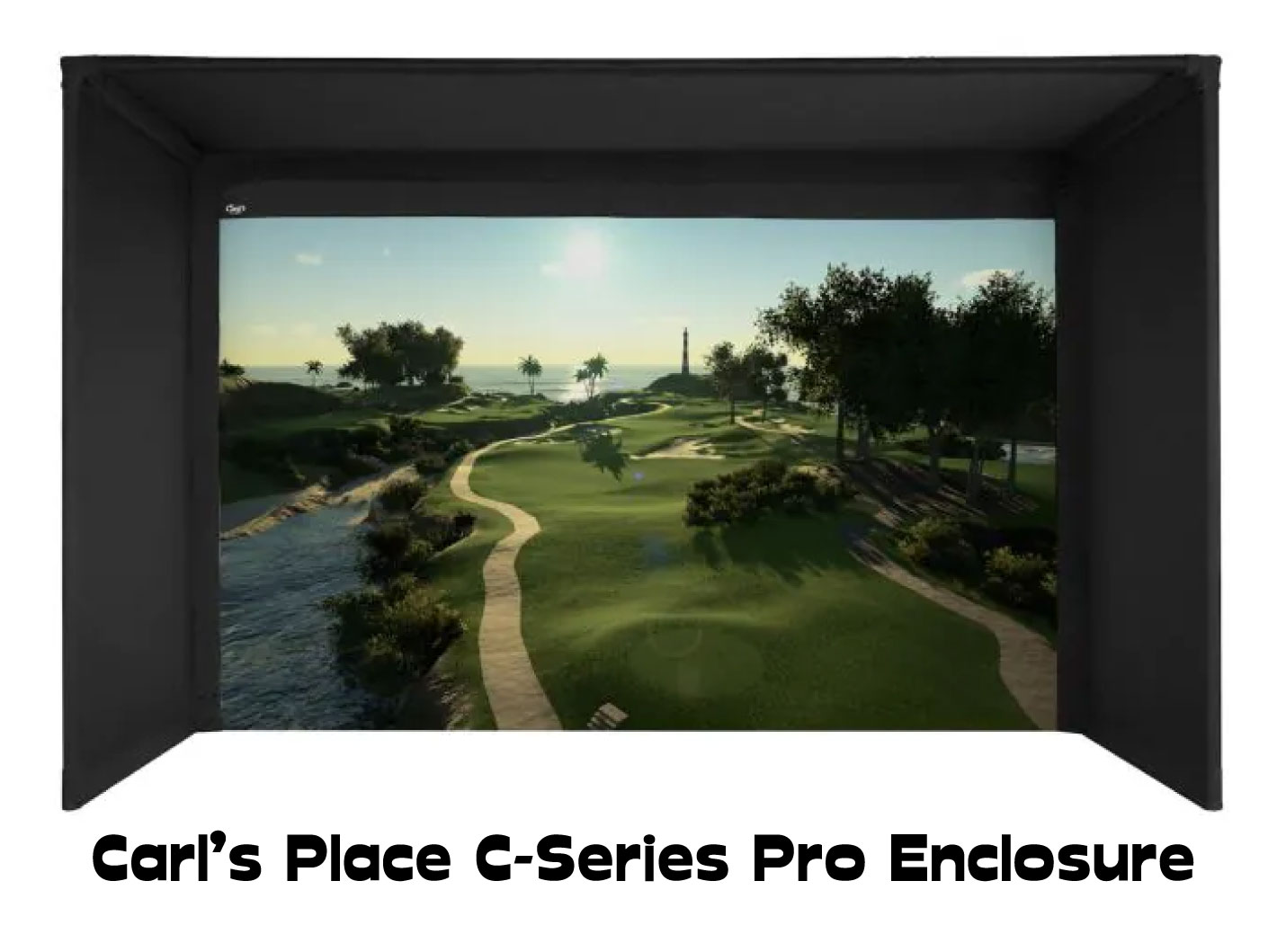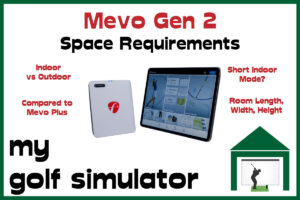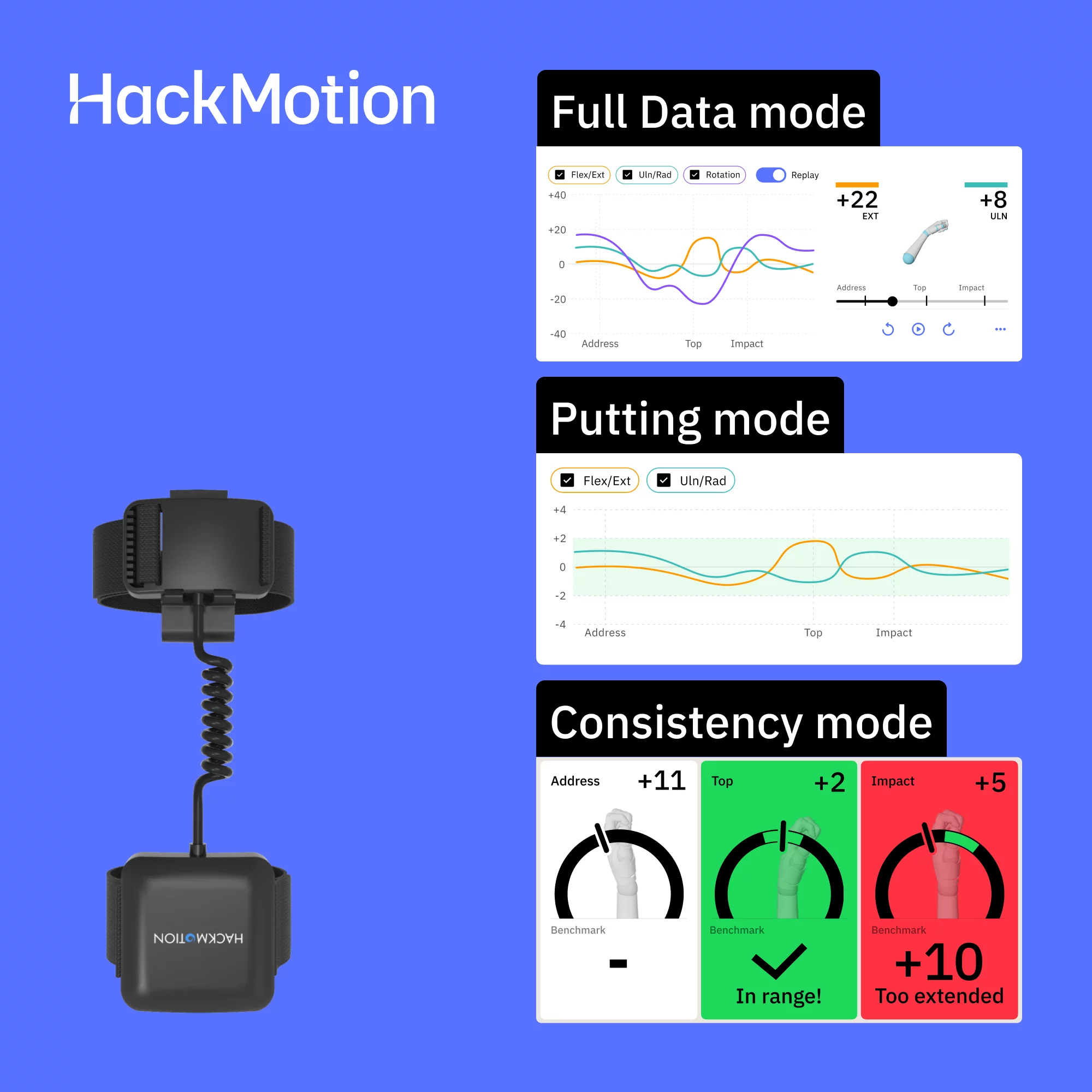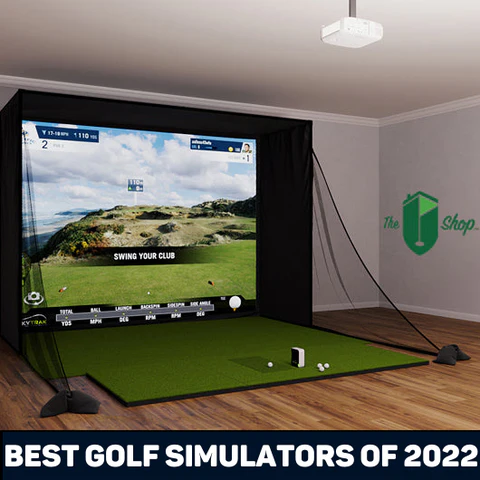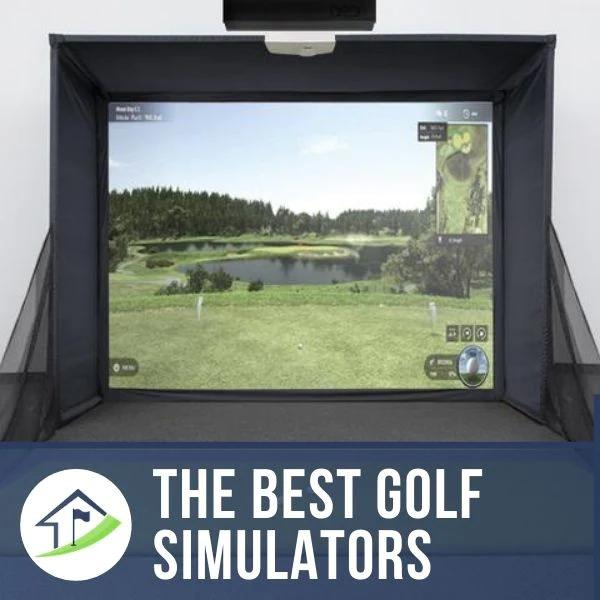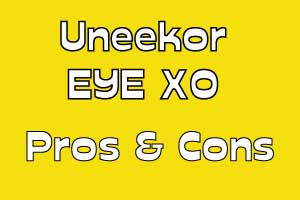Gray Impact Screens – Pros and Cons
Posted in Golf Impact Screens
Over the past year, gray impact screens have started making a real mark in the golf simulator market, with major brands like Carl’s Place and SIGPRO now offering purpose-built gray options alongside their traditional white models.
Quick Verdict: Are Gray Impact Screens Better Than White Screens?
Gray impact screens aren’t automatically better than white—they’re better in specific room conditions. Gray wins in brighter or mixed-light spaces, where it absorbs stray light and preserves contrast. White wins in fully dark, controlled rooms, where its extra brightness and pop really stand out.
One-line recommendations:
- Mixed-use golf sim + home theater: Go Gray for balanced performance in both setups.
- Bright room with ambient light: Go Gray for deeper blacks and less washout.
- Dedicated dark sim room: Go White for maximum brightness and vivid color.
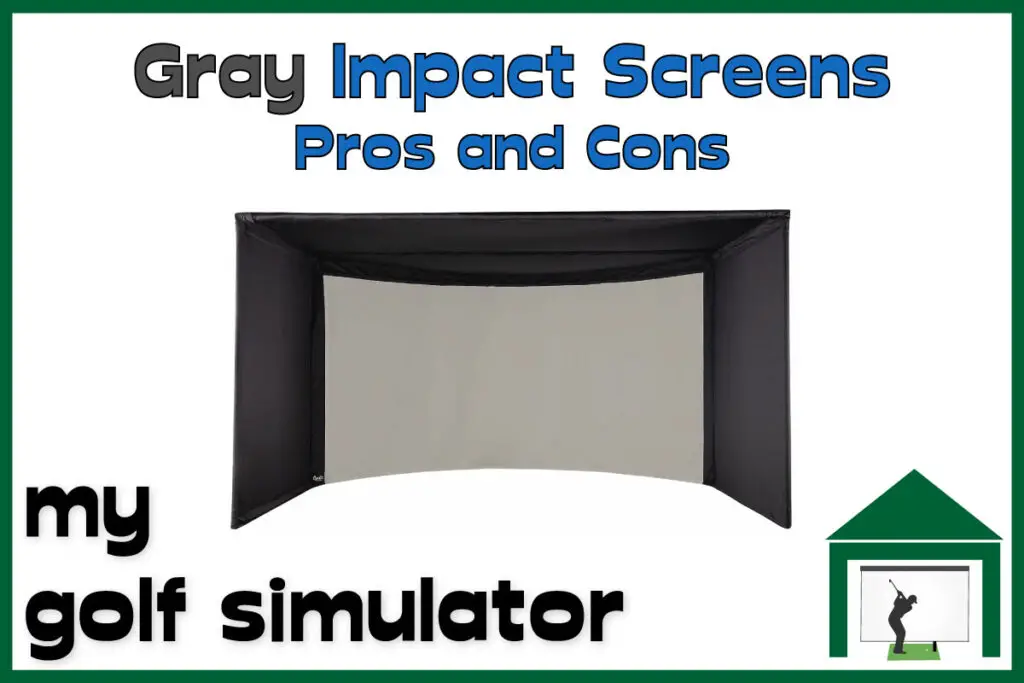
How Projection Color and Light Interact: The Optics Behind Gray vs White Screens
When you fire up a projector, the image you see is a mix of two things: the light coming off the screen and the stray light bouncing around the room. The color of the screen changes how much of each gets reflected back to your eyes.
Brightness and perceived image
White screens reflect more of the projector’s output, so they look brighter at the same lumen level. Gray screens reflect less, which lowers peak brightness but helps balance the image in trickier lighting.
Reflectance, gain, and peak brightness
Most golf impact screens are rated close to a gain of 1.0, meaning they reflect light evenly in all directions. Switching from white to gray doesn’t change the construction—it changes the reflectance. A gray screen will naturally look dimmer unless you boost projector output or tighten up light control.
Contrast and black levels
Where gray shines is contrast. By absorbing more ambient light, it keeps blacks looking darker instead of gray and improves the separation between light and dark areas. That means fairways, bunkers, and tree lines carry more depth, even if the overall image is a touch less bright.
Why ambient light matters more than screen color alone
The biggest factor isn’t the screen—it’s your room. A bright white wall, open window, or overhead light will all scatter light across the screen and flatten the image. Gray screens can fight back, but they can’t fully cancel poor lighting.
Influence of windows, lights, and wall colors
Uncovered windows and downlights are the main culprits for washout. Even wall color plays a role: light walls reflect spill back onto the screen, softening the picture. That’s why many golfers with gray screens still use blackout curtains, dimmable lights, or darker wall paint to get the best out of their setup.

Performance Comparison: Image Quality, Contrast, and Color Accuracy
Side-by-side testing shows that the biggest difference between gray and white screens is contrast in ambient light. White screens look brighter overall, but their blacks and shadow detail fade quickly once you add daylight or overhead lighting. Gray screens hold onto darker tones, so the image feels richer and less washed out.
Measurable differences
In controlled tests, gray screens typically deliver 25–30% higher contrast ratios than white screens under the same lighting conditions. That means tree lines, bunkers, and shaded fairways appear with more definition, even if the peak brightness is slightly lower.
Perceived brightness
Because the human eye is more sensitive to contrast than raw brightness, a gray screen can often look more “realistic” in bright rooms despite technically reflecting fewer lumens. In a dark, fully controlled space, though, a white screen still wins on maximum brightness and punch.
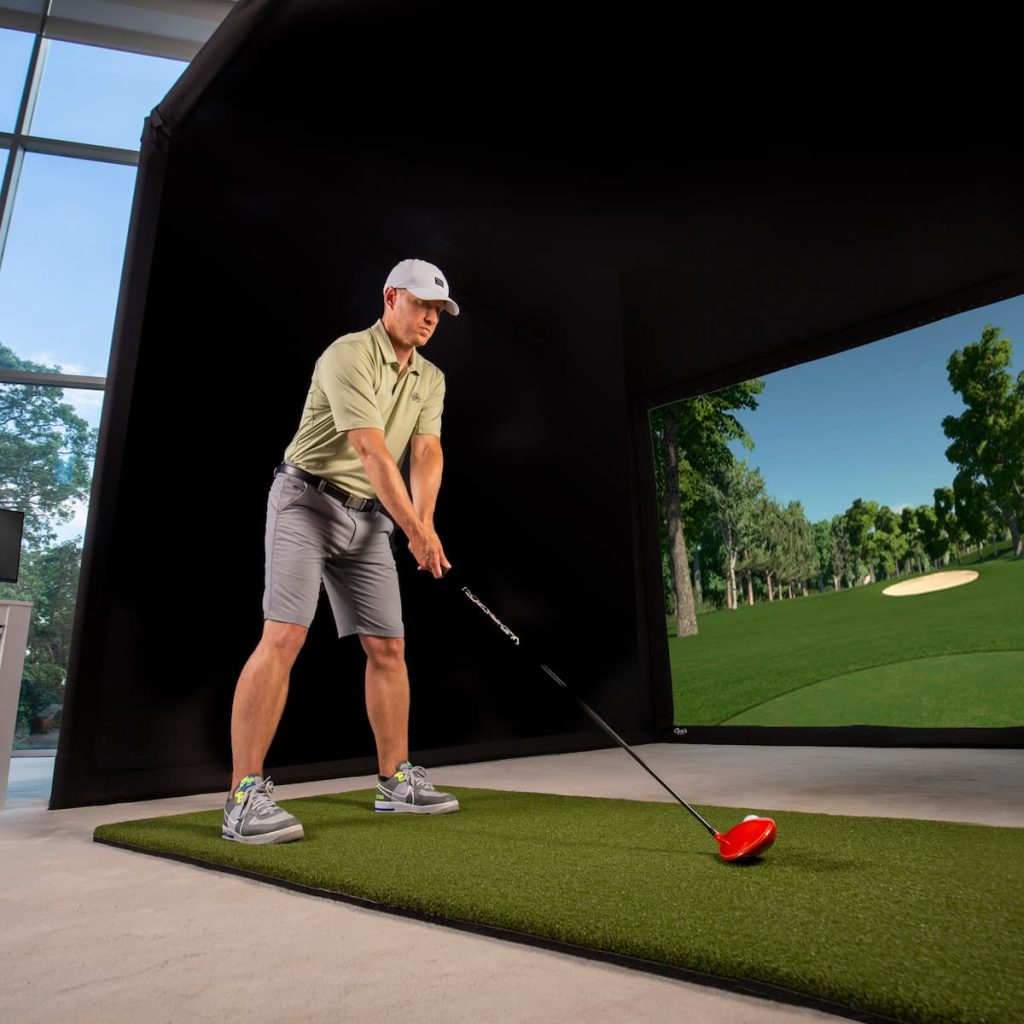
Color Accuracy and Saturation: Real-World Implications for Golf Sims
Color balance is where the gray vs white debate gets more subtle. Gray screens can slightly mute overall brightness, but when paired with a decent projector, they often deliver more natural saturation in challenging lighting. Greens look less fluorescent, skies hold their depth, and shaded areas retain their detail instead of blending into flat gray.
Managing color shift with calibration
Any minor color shift introduced by a gray surface can be corrected with projector calibration. Adjusting brightness, contrast, and color temperature restores balance, letting you keep the contrast benefits of gray without sacrificing realism.
4K and high-resolution projectors
Modern projectors with 4K output handle both gray and white screens well. White screens maximize pixel brightness, while gray screens trade a small amount of that brightness for improved definition in mixed-light rooms. With 4K projectors pushing more light and sharper pixel density, the brightness penalty of gray is less noticeable.
Recent 4K optimization technologies
Manufacturers like SIGPRO and Carl’s Place now market their gray screens as fully 4K-ready. Improved weaves and coatings reduce sparkle, moiré, and hotspotting, ensuring gray fabric delivers the same pixel precision as white while maintaining its contrast advantage.
Impact of material and texture on clarity
Screen texture plays a big role in how sharp the image looks. A smoother, tighter weave preserves clarity at 4K, whether gray or white. Poorly woven or uneven surfaces can introduce visual artifacts, but premium models like the SIGPRO Premier Impact Screen and Carl’s High Contrast Gray Screen are engineered to avoid these issues, giving you crisp visuals no matter the screen color.
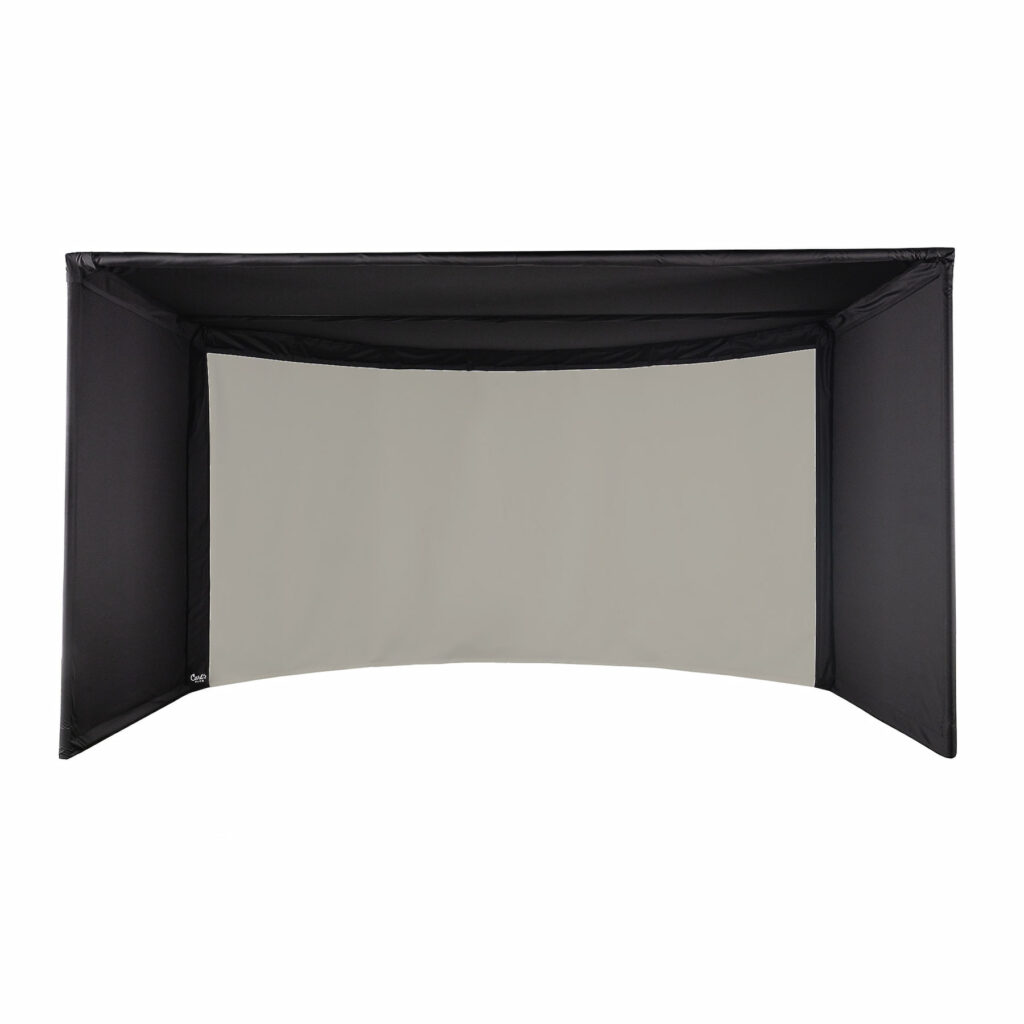
Projector Compatibility: How to Choose a Projector for a Gray Impact Screen
Your projector choice is just as important as the screen itself. A gray impact screen can transform image quality in the right setup, but only if the projector has the muscle to drive it.
Recommended lumen ranges
White screens are more forgiving of lower-brightness projectors. If your unit produces under about 2,500 lumens, a white screen will give you a noticeably brighter picture in a dark room. Gray screens really come into their own once you’re at 3,000 lumens or higher, where the extra output offsets the gray surface’s light absorption.
Low-lumen projectors (<2,500 lm)
Best paired with white screens in controlled lighting. Gray will look too dim and washed out without enough light to drive it.
Mid/high-lumen projectors (3,000+ lm)
Ideal for gray screens, especially in brighter or mixed-use rooms. At these levels, gray no longer feels dim, and the contrast improvements are clearly visible.
Throw ratio, lens shift, and focusing
Short-throw ratios (0.5–0.8) are the standard for golf simulators. Whether you go gray or white, look for projectors with flexible lens shift, auto focus, or digital geometry correction so you can fill the screen cleanly without distortion.
HDR, color space, and settings
Gray screens pair well with projectors offering HDR10 and wide color gamuts. Settings like Rec.709 or Rec.2020 help maintain accurate color even with the gray surface absorbing some brightness. Always double-check gamma and brightness profiles—what looks perfect on a white screen may need a few clicks of adjustment on gray to achieve the same realism.
| Projector Model | Buy Now | Resolution | Lumens | Throw Ratio | Contrast Ratio | Aspect Ratio (Native) | Aspect Ratios (in settings) | Golf Mode Option | Lens Shift | Keystone Correction | Light Source |
|---|---|---|---|---|---|---|---|---|---|---|---|
| BenQ TH671ST | Buy Now! | 1080p (1920 x 1080) | 3000 | 0.69–0.83 | 10,000:1 | 16:9 | Auto; 16:9; 4:3 | No | None | Vertical ±40° | Lamp |
| BenQ LU710 | Buy Now! | WUXGA (1920 x 1200) | 4000 | 1.13–1.46 | 3,000,000:1 (dynamic) | 16:10 | Auto; 16:10; 16:9; 4:3; Real | Yes | None | 2D: H/V ±30° (Corner Fit) | Laser |
| BenQ AH500ST | Buy Now! | 1080p (1920 x 1080) | 4000 | 0.499 | 3,000,000:1 (dynamic) | 16:9 | Auto; 16:9; 4:3; 16:10; Real | Yes | None | H/V ±30° | Laser |
| BenQ AH700ST | Buy Now! | 1080p (1920 x 1080) | 4000 | 0.69–0.83 | 3,000,000:1 (dynamic) | 16:9 | Auto; 16:9; 4:3; 16:10; Real | Yes | None | 3D: H/V ±30° + Rotation ±30° | Laser |
| BenQ TK710STi | Buy Now! | 4K UHD (3840 x 2160) | 3200 | 0.69–0.83 | 600,000:1 (dynamic) | 16:9 | Auto; 16:9; 4:3 | Yes | None | 3D: H/V ±30° + Rotation ±30° | Laser |
| Optoma ZH450ST | Buy Now! | 1080p (1920 x 1080) | 4200 | 0.496 | 2,000,000:1 (dynamic) | 16:9 | 16:9; 16:10; 4:3 | No | None | H/V ±30° | Laser |
| Panasonic PT‑VMZ51 | Buy Now! | WUXGA (1920 x 1200) | 5200 | 1.09–1.77 (1.09–2.21 with Digital Zoom Extender) | 3,000,000:1 (dynamic) | 16:10 | 16:10; 16:9; 4:3 | No | H ±20%, V +44% | H ±35°, V ±25° | Laser (3LCD) |
| BenQ AK700ST | Buy Now! | 4K UHD (3840 x 2160) | 4000 | 0.69–0.83 | 3,000,000:1 (dynamic) | 16:9 | 16:9; 16:10 (Auto Screen Fit) | Yes | None | 3D: H/V ±30° + Rotation ±30° | Laser |
| LG ProBeam BU53RG | Buy Now! | 4K UHD (3840 x 2160) | 5000 | 0.94–1.14 | 3,000,000:1 (dynamic) | 16:9 | 16:6; 16:9; 16:10; 21:9; 4:3 | No | H ±20%, V ±50% | Advanced edge adjustment & warping (4/9/15/25‑point) | Laser |
| BenQ LK936ST | Buy Now! | 4K UHD (3840 x 2160) | 5100 | 0.81–0.89 | 3,000,000:1 (dynamic) | 16:9 | 5 selectable (incl. 16:9/16:10/4:3/Real) | Yes | H ±23%, V ±60% | 3D: H/V ±40° + Rotation ±40°; Warping | Laser |
| EIKI EK-308U | Buy Now! | WUXGA (1920 x 1200) | 6000 | 1.07–1.75 | 10,000:1 | 16:10 | 16:10; 16:9; 4:3 | No | Vertical ±45%, Horizontal ±9% | Vertical ±30°, Horizontal ±15° | 3LCD (Lamp) |
| Optoma ZW350ST | Buy Now! | WXGA (1280 x 800) | 3600 | 0.521:1 | 300,000:1 | 16:10 | 16:10; 16:9; 4:3 | Yes | None | Vertical ±15° | Laser (30,000 hours life) |
Room Scenarios and Recommendations: Choosing by Room Type and Use Case
Dedicated, light-controlled simulator room
If you’ve built a purpose-made sim room with blackout curtains, dark walls, and full control over lighting, a white screen is usually the better choice. White reflects more of your projector’s output, so you’ll get maximum brightness and vivid “pop” from fairways, skies, and greens.
With no ambient light to wash things out, the contrast advantage of gray screens disappears. In these controlled spaces, a high-quality white screen like the SIGPRO Premier will give you the clearest, most vibrant image possible.
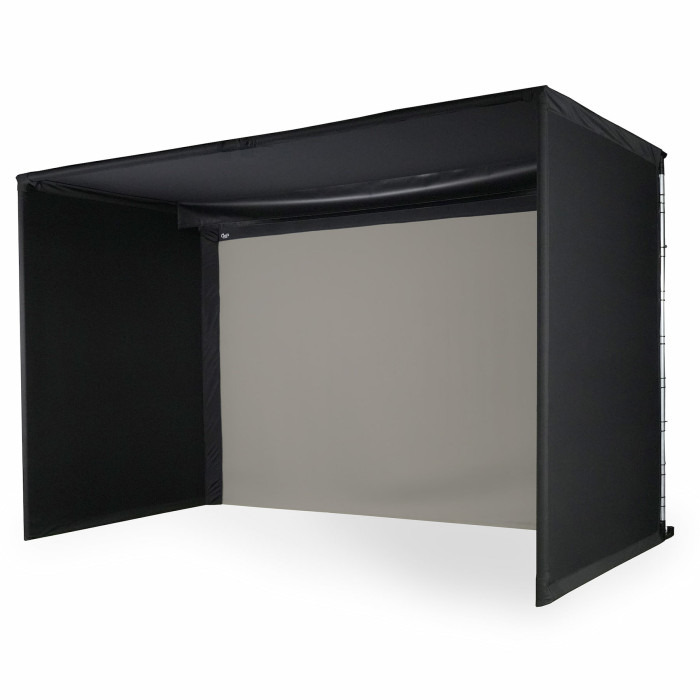
Multi-Use Rooms and Home Theaters That Double as Simulators
Grey impact screens have quickly become the go-to choice for shared family spaces where you can’t black out every light. In user reviews, owners of grey screens consistently noted that colors held up far better with lamps on or blinds open compared to their old white screens. Manufacturers like Carl’s and SIGPRO now even market grey as “dual-use” because of its ability to preserve contrast in a living room or basement that doubles as a theater.
- Advantage: Grey fabric absorbs ambient light spill, which means deeper blacks and less washout when your projector is competing with side light or daylight.
- Trade-off: If your projector is underpowered (<2,500 lumens), the image may look dimmer than on a white screen. Calibration usually solves minor color shifts.
Commercial Venues, Indoor Golf Complexes, and Entertainment Spaces
In commercial bays, it’s nearly impossible to create perfect light control — there are always overhead lights, signage, and spectator areas. That’s why installers frequently specify grey screens as standard. Independent testing in 2025 showed a 25–30% contrast improvement for grey under ambient light versus white, and operators report customers perceive the image as “more premium” even with cheaper projectors.
- Common specs in high-ambient venues:
• Grey, triple-layer mesh with a gain around 0.8–1.0
• Reinforced edges and tension mounts for heavy use
• Sizes from 14–20 ft wide, often 16:9 for mixed sim/theater projection - Benefit: Grey minimizes complaints about washed-out images in open environments, while still meeting impact-resistance requirements.
Small Rooms Versus Large Bay Setups
Small simulators (garage, spare room) typically benefit from white if the room can be blacked out, because the screen is closer and the projector throw distance is shorter — brightness matters more. But if the room also hosts other activities, grey still has an edge in image quality with lights on.
Large bays (15 ft+ wide) in basements or commercial builds lean strongly toward grey. The wider the screen, the more challenging it is to control ambient light, and the larger surface area makes contrast loss more noticeable.
- Aspect ratio considerations:
• 1:1 or 4:3 in tight spaces, often white unless mixed-use.
• 16:9 or 16:10 in larger builds — grey helps maintain cinematic performance for both golf and movie content. - Layout tips: Grey screens benefit most when paired with 3,000+ lumen projectors and walls/ceilings treated in darker tones.
✅ Key takeaway:
Use grey in multi-use, commercial, or large-bay spaces where ambient light is harder to control and you want better contrast and color integrity.
Use white in small, dark, single-purpose sim rooms with modest projectors.
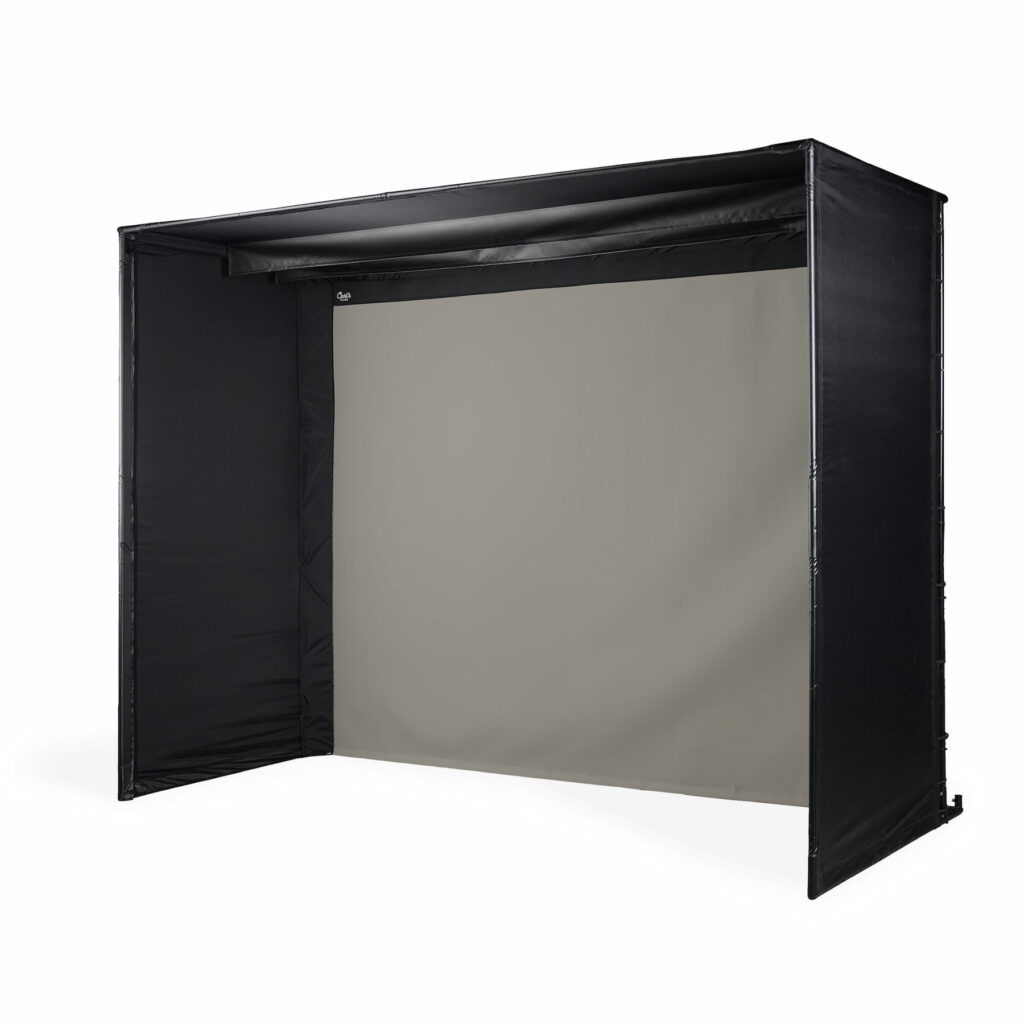
Materials, Construction, and Durability: What Makes an Impact Screen Perform
Most premium impact screens use a triple-layer polyester mesh construction with spacer yarns. This design helps spread the force of a golf ball across the surface, reducing bounce-back and lowering noise. The inner layers absorb impact energy while the outer surface provides the smooth finish needed for sharp projection.
Gray and white versions are usually built on the same base fabric. The main differences come from surface coatings, weave tightness, and texture. Gray coatings are designed to absorb more ambient light without sacrificing clarity, while white surfaces prioritize brightness. Both maintain a tight weave to stay compatible with high-resolution projectors.
Durability is generally the same between gray and white models of the same screen family. Tear resistance depends more on overall thickness and stitching than on color. With regular use, both will show wear at the center strike zone over time, but rotating or flipping the screen can extend its life. Maintenance mainly comes down to spot cleaning and keeping the surface free of dirt or ball marks.
Recent releases in 2024 and 2025, such as the SIGPRO Premier and Carl’s High Contrast Gray, show improvements in material engineering. Manufacturers are working on coatings that resist ball scuffs, fabrics that minimize sound on impact, and tighter weaves that prevent moiré patterns on 4K projectors. These updates make today’s gray and white screens more durable and visually consistent than older generations.
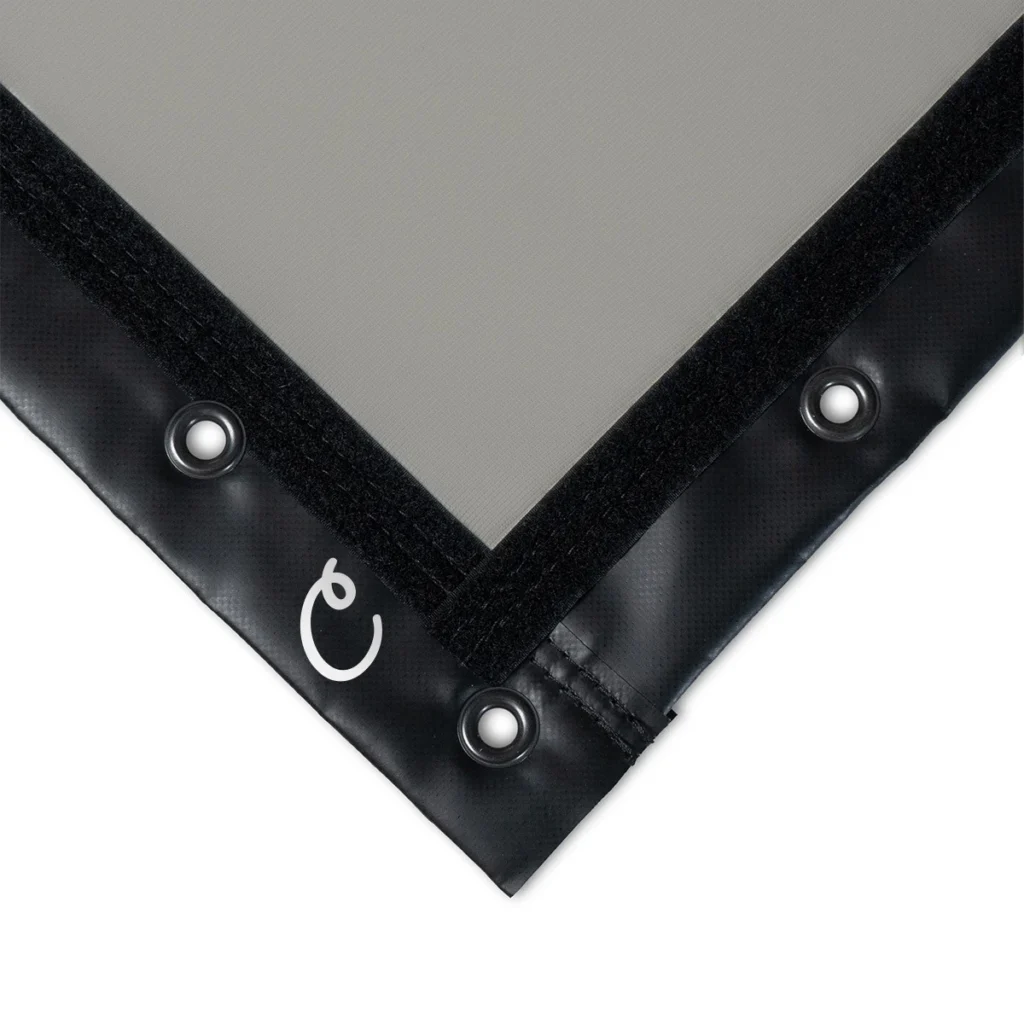
Price Vs Value for Gray Screens
Value is maximized when you pair the screen color to your room: gray for bright or multi-use spaces, white for dark controlled setups.
Gray screens used to command a significant premium, but in 2024–2025 the difference has narrowed to around 10–15% more than white.
With Carl’s High Contrast Gray and the SIGPRO Premier now widely available, competition has pushed down costs.

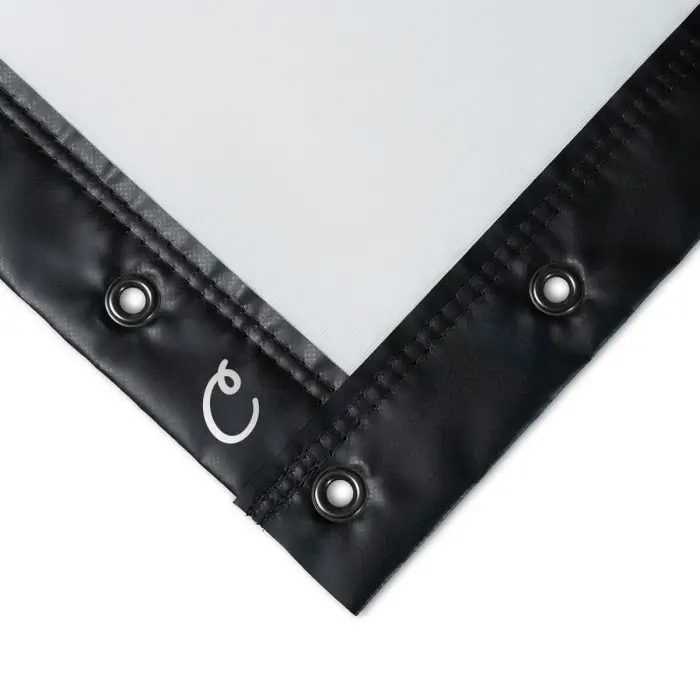
Commercial Versus Residential Buying Considerations
Why commercial operators prefer gray screens
Golf bars, teaching bays, and entertainment venues often run with lights on and plenty of ambient brightness. Gray screens maintain image contrast in these environments, keeping visuals sharp and professional-looking for customers. They also minimize the “washed out” look that can occur on white screens in brightly lit spaces.
Heavy-use requirements
Commercial installations demand durability, safety, and consistency. Screens need to handle thousands of strikes without tearing, while also being fire-rated and installed with proper framing for liability coverage. Reinforced edges, tension mounting, and warranties become more important in these heavy-use setups than in home environments.
Tradeoffs for home users
Residential buyers weigh different factors. Aesthetics, integration into a living space, and cost often come first. A free-hanging white screen may be perfectly acceptable in a dedicated dark sim room. Gray screens, however, add value in shared spaces like garages or basements where ambient light is harder to control.
Future Outlook: Trends Shaping the Gray Versus White Debate
The rise of multi-use rooms
More households want spaces that double as golf simulators and home theaters. Gray screens excel in this role, balancing performance across both dark and bright viewing conditions. As multi-use rooms become the norm, gray screens are set to move from specialist choice to mainstream default.
Growing availability
Major brands like Carl’s Place and The Indoor Golf Shop now offer gray versions of their flagship screens. Gray is no longer a niche option—it’s becoming standard alongside white.
Increasing projector lumen levels
With 3,000–5,000 lumen projectors becoming more affordable, the brightness penalty of gray screens matters less. Stronger light output ensures gray screens perform well without looking dim.
Advances in material science
Manufacturers are investing in smoother weaves, 4K-optimized fabrics, and coatings that resist scuffing. Experimental technologies include integrated sensors for ball-tracking feedback and self-healing fabrics for longer life.
User Experience: Evaluating And Comparing Screens In Real-world Settings
User Opinions on Gray Impact Screens
Positive Feedback
- Better contrast and deeper blacks in rooms with ambient light.
- Useful for multi-use setups (golf + movies/sports).
- Helps colors “pop” and reduces washout compared with white screens.
- Commercial users expect gray to perform better in bright venues.
Concerns and Tradeoffs
- Lower brightness vs white, especially with projectors under ~2,500 lumens.
- Some users see little difference in darker, controlled rooms.
- Risk of moiré or texture issues if the weave isn’t optimized for 4K.
- A few say “not much difference” unless room light is a real issue.
Practical Questions Users Raise
- Should I upgrade my projector or switch to gray?
- Is gray worthwhile if I only use the sim for golf, not movies?
- Are the latest premium whites already good enough in most conditions?
Overall Takeaway
Golfers are split: gray screens shine in brighter or mixed-use spaces, but in fully dark sim rooms, many still prefer white for maximum brightness and simplicity. Enthusiasts agree that projector quality and room lighting matter more than screen color alone.
Final Thoughts – Gray vs White Impact Screens
- Gray screens are now widely available, with Carl’s Place and SIGPRO both launching premium gray options in 2025.
- The main advantage of gray is contrast in ambient light, making them ideal for garages, teaching bays, and multi-use rooms.
- White screens remain best for dedicated dark simulator rooms, where their extra brightness and “pop” stand out.
- Gray screens typically need 3,000+ lumens to shine, while white can work with lower-lumen projectors.
- Both gray and white versions share similar triple-layer polyester mesh construction for durability and ball strike resistance.
- Recent innovations include 4K-optimized fabrics, tighter weaves, and coatings that reduce scuff marks and improve clarity.
- Gray screens are increasingly favored for dual-use golf sim + theater setups, while white remains strong for purist golf environments.
- The price premium for gray has narrowed, making them more accessible to home users.
- User feedback highlights that room lighting and projector strength matter more than screen color alone.
- The market trend is clear: gray is moving from niche option to mainstream choice as projector brightness climbs and multi-use spaces become the norm.
Frequently Asked Questions
Q: What is the main benefit of a gray impact screen?
A: Gray screens absorb more ambient light, which improves contrast and keeps images from looking washed out in brighter rooms.
Q: Do gray screens look dimmer than white screens?
A: Yes, gray reflects less light, so peak brightness is lower. With projectors over 3,000 lumens, this difference is less noticeable.
Q: Which screen is better for a dark, dedicated simulator room?
A: A white screen. In controlled lighting, white provides maximum brightness and vivid colors without the need for gray’s contrast boost.
Q: Are gray impact screens more expensive than white ones?
A: The price gap has narrowed. In 2025, gray models from Carl’s Place and SIGPRO are only about 10–15% more than white versions.
Q: Do I need a special projector for a gray screen?
A: Not necessarily, but gray works best with mid to high lumen projectors (3,000+). Low-lumen projectors may look too dim.
Q: Are gray screens durable enough for heavy use?
A: Yes. Both gray and white use the same triple-layer polyester mesh construction with strong impact resistance and long life.
Q: Can gray screens be used for home theater as well as golf?
A: Definitely. Gray screens are often recommended for dual-use setups, as they balance brightness and contrast across both golf and movie viewing.
Q: Do gray screens affect 4K or high-resolution projection quality?
A: Modern gray screens are optimized for 4K with tight weaves and coatings to prevent moiré and preserve pixel clarity.
Q: Do gray impact screens make the image darker?
A: Yes. Gray reflects less light than white, so the overall image is slightly dimmer. With a projector over 3,000 lumens, the brightness difference is minor.
Q: Will a gray screen work with a low-lumen projector?
A: Not well. Under about 2,500 lumens, a gray screen can look too dim. In that case, a white screen is the better option.
Q: Are gray impact screens better for 4K projectors?
A: Yes. Modern gray screens are optimized for 4K with tighter weaves and coatings that reduce moiré and preserve pixel clarity. They show their benefits most when paired with high-resolution projectors in brighter rooms.
Q: Do gray screens change color accuracy?
A: Slightly. Gray can mute brightness, but proper projector calibration restores balance. Many users find that colors, especially greens and blues, look more natural on gray screens in ambient light.
Q: How much more do gray screens cost than white screens?
A: In 2025, the price gap has narrowed to about 10–15% more for gray. The premium is much smaller than in past years.
Q: Can a white screen be retrofitted to mimic gray behavior?
A: Not really. Some users experiment with gray paints or overlays, but these often reduce sharpness and durability. Purpose-made gray screens perform much better.
Q: Which screen is better for a multi-use room that doubles as a home theater?
A: Gray. It balances brightness and contrast across both golf simulation and movie viewing, handling ambient light better than white in a shared space.
Mevo Gen 2 Space Requirements
Golf Mode – Do You Need It In Your Simulator Projector?
ABOUT THE AUTHOR
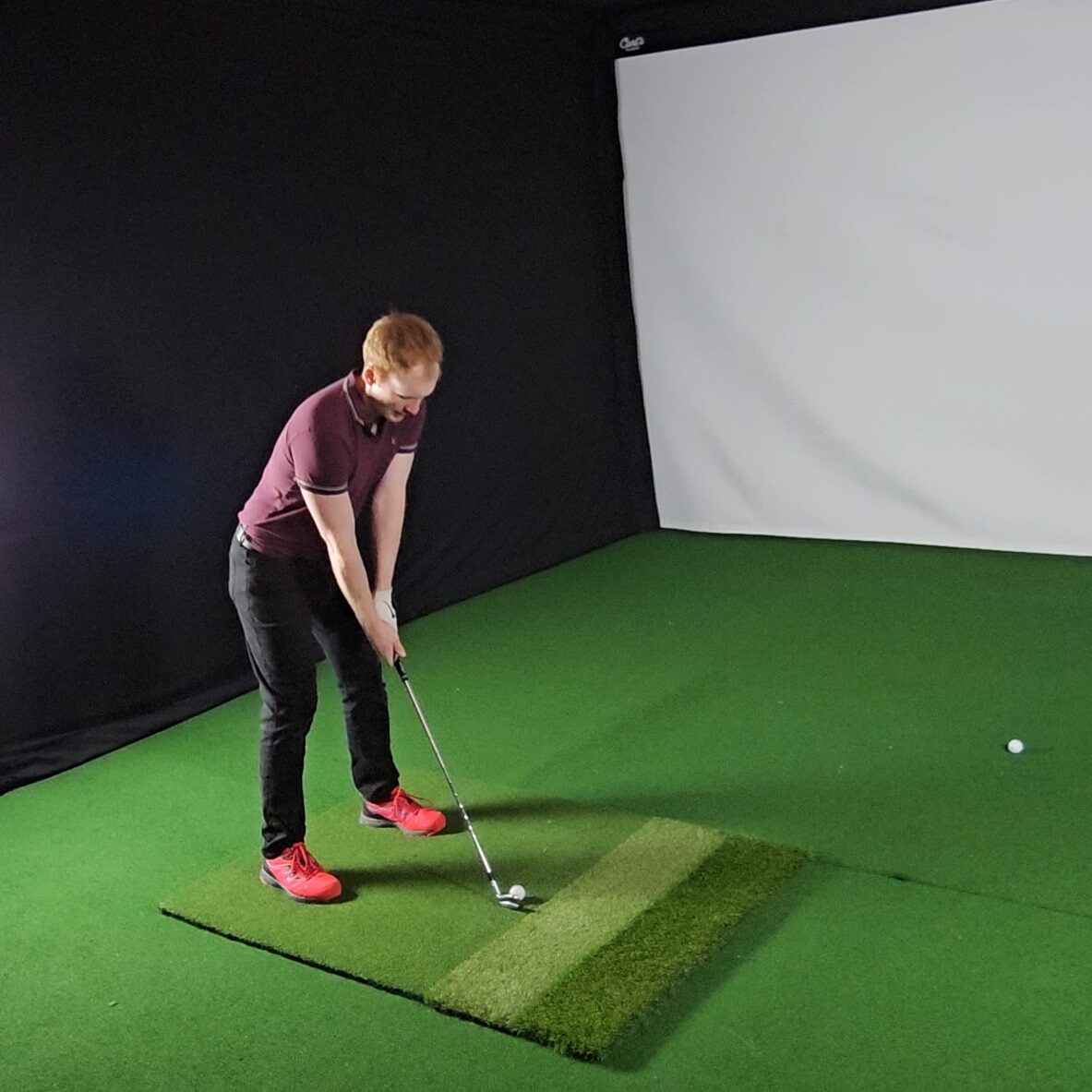
Hello! My name is Alex and it is my mission to bring you all the information you need to build your own home golf simulator! I hope mygolfsimulator.com helps you on your journey to better golf at home!
LEGAL INFORMATION
On this site, you'll find articles on all aspects of building a golf simulator. I will also link to other sites where you can buy some of the simulator components. Some of these links may be affiliate links, which means if you click them I gain a small commission at no extra cost to you. This really helps out me and my site so thank you in advance! mygolfsimulator.com and all related social media accounts are property of Awonline LTD.
